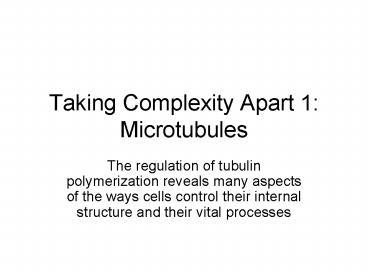Taking Complexity Apart 1: Microtubules - PowerPoint PPT Presentation
1 / 27
Title:
Taking Complexity Apart 1: Microtubules
Description:
The regulation of tubulin polymerization reveals many aspects of the ways cells ... evidence that MTs are really thermolabile, vs. low temperature having an effect ... – PowerPoint PPT presentation
Number of Views:107
Avg rating:3.0/5.0
Title: Taking Complexity Apart 1: Microtubules
1
Taking Complexity Apart 1 Microtubules
- The regulation of tubulin polymerization reveals
many aspects of the ways cells control their
internal structure and their vital processes
2
Summary diagram of MT formation from tubulin
subunits
3
Tubulin can polymerize efficiently when nucleated
by a preformed structure, e.g., an existing MT.
The resulting polymerization shows biased rates
faster at the plus end (which is the distal
end of an axoneme).
4
In vivo, MTs are initiated from specific
structures. They grow with plus ends distal to
the sites of initiation
- In animal cells, this initiating site is the
centrosome, and many cells have radial MT arrays,
emanating from this structure - In many protozoa, the MTs form complex cortical
arrays. - In plants, they are usually arranged
circumferentially inside the plasma membrane (PM)
5
(No Transcript)
6
MTs growing either in vitro or in vivo can be
monitored and analyzed by fluorescence
microscopy, even though a MT is much narrower
in diameter than the resolving power of
the light microscope. Detection and resolution
are not the same thing. Here we see a MT moving
in vitro by addition of subunits at one end and
loss at the other, a process called treadmilling.
7
Tubulin polymerization can do work
- Recall the Tilney and Porter paper
- What is the evidence that MTs are really
thermolabile, vs. low temperature having an
effect on some other aspect of cell biology? - What does cold-sensitivity tell you about the
bonds between tubulin subunits
8
In vivo, MTs play some role in controlling the
position of other cytoplasmic components
- Dynamically unstable MTs approach the cell cortex
and contribute to its activity - MTs bind both laterally and at their tips to
membranes of the ER, affecting their
organization - MTs can push and pull on objects that they grow
into
9
Fluorescent MTs in time-laps at the cells
periphery, showing Dynamic Instability and the
interaction of MTs with ER
10
Dynamic instability is based mostly on
polymerization activity at the MTs plus end,
which lies near the cell periphery
- It is the peripheral end that appears most
active, but it could be MT motion back and forth. - Using low levels of fluorescently labeled
tubulin, one gets uneavenly labeled MTs - The resulting speckles are markers for the
position of the MT wall as the tip position
fluctuates
11
(No Transcript)
12
EMs (top) and diagrams (bottom) of of
frozen-hydrated MTs, elongating (left) and
shrinking (right) MTs, showing the difference in
minimum energy shape that derives from GTP
hydrolysis.
13
TEM of an animal cell Centrosome, showing
the Centriole and the Peri- Centriolar Material
(PCM)
Diagram and TEM images of MT initia- tion by
gamma- tubulin
14
MTs displaying dynamic instability after
initiation by a centrosome in vitro
15
MTs in vivo can become releasedfrom the
centrosome and move away
16
Given all this, how does MT polymerization push
outward on a plasma membrane?
- What does bond energy (e.g., tubulin-tubulin
bonds) mean in this context? - How can it be converted into force?
- How does Brownian motion fit into the picture?
- Can all this be put into a model that makes
physical sense?
17
Behavior of MTs in vivo is controlled in part by
associated protein molecules
- We have seen that centrosome can serve as sites
for MT polymerization, helping to define the site
of initiation, the direction of growth, and the
orientation of the polymer (plus end distal). - Some proteins bind to tubulin dimers, rendering
them incapable of polymerization and combating
polymer formation - Some proteins bind to polymers and stabilize
them, promoting polymerization. - Then there are additional, more complex
MT-associated proteins whose modes of action are
not well understood
18
Small, soluble proteins can bind to soluble
Tubulin, forming a complex that wont polymerize
Such proteins often increase the likelihood of MT
catastrophes, making MTs shorter on average.
19
In complex cells like neurons, MTs can take on
several roles helped in this process of
differentiation by companion proteins that bind
to the polymerized state. These are called
MT- Associated Proteins, or MAPs.
20
(No Transcript)
21
EB1-GFP tracks the growing ends of cytoplasmic
MTs in vivo
22
What are the relationships between EB1 and the
CLIP170 described in the reading?
- Evidence for position?
- Evidence for mechanism for positioning?
- Interactions?
- So What?
23
There are also proteins that bind to MTs
and Promote their disassembly catastrophins
24
(No Transcript)
25
Some proteins are tethered to other parts of the
cytoplasm, such as the cell cortex, and these can
capture the plus ends of MTs, anchoring them to a
structure of interest.
26
Cell morphology is a result of the internal
control of MT polymerization, binding, and
stability
27
In cells where shape plays a key role in
cell Function, this elaboration of complexity and
Structure can get complex. In fact, it
depends Not just on MTs but also MFs, our next
topic.































